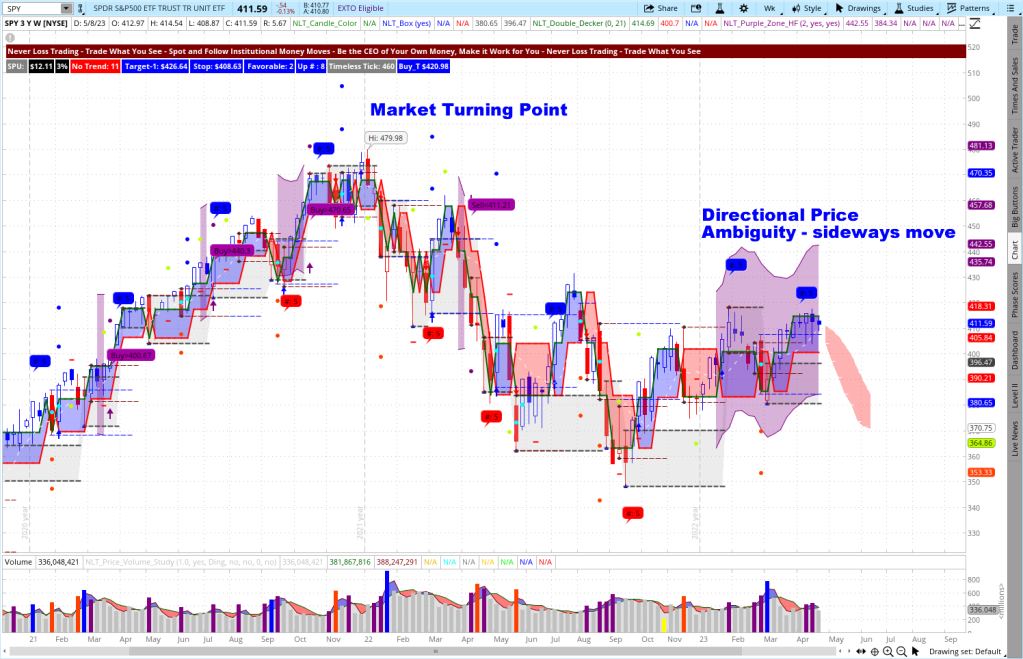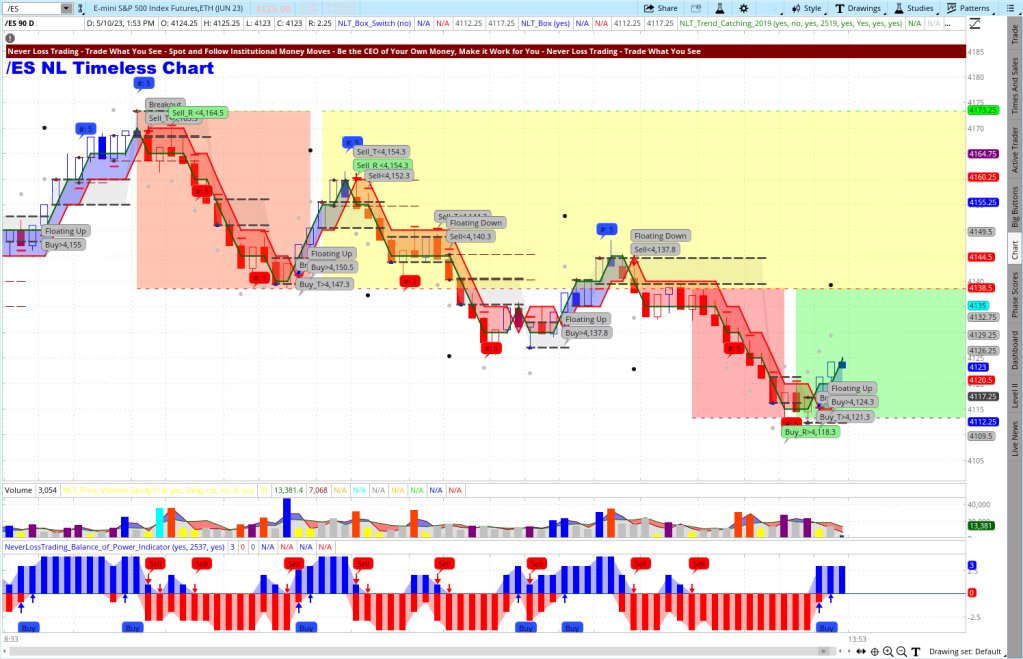We had an up-trending market for more than ten years, but this changed in 2022 when the market started to go down and moved sideways. In such an environment, longer-term buy-and-hold does not yield desired returns; shorter-term strategies are the better choice:
- Day Trading
- Swing Trading

Last week’s article explained how to swing trade with the NeverLossTrading Concept, and we do not want to repeat the same message; if you are interested in holding positions for multiple days, please check for our concepts here.
Day trading is when a trader buys and sells securities on the same day. However, more than 76% of short-term traders lose money; hence, knowing how to day trade is not generic, and we want to assist in applying suitable strategies. If you do not believe this number, we are happy to back it up:
contact@NeverLossTrading.com Subj.: 76%
Before we dive into the topic, let us give a short stock market overview of the S&P 500 based on SPY (ETF), and you see an expanding purple zone (directional price ambiguity), reaching from the week of 1/16/2023 to today (May 12, 2023). Hence, we do not want to commit to longer-term trades when institutional investors do not: We follow the market and trade what it allows.
Stock Market Development 2020 to 2023

Taking a Narrow and indicator-based view:

NeverLossTrading follows institutional money moves:
- Institutions have better tools for analyzing the markets
- They have more insights than private investors
- We do not have an edge in competing for knowledge
However, we have an edge:
- By the size of their investments, they need to scale in and out of potions, and our indicators find changes in supply and demand that lead to a high likelihood of directional price moves
- We copy their action and gain an edge by opening and closing entire positions faster than they can
Day trading is one way of participating when we have no longer-term commitment, and it has several advantages, including:
- Potential for high returns: Day traders can earn high returns on their investments by taking advantage of small price movements within a single day. The high percentage of failing day trades follows a high participation rate, and we will share how to act differently.
- Flexibility: You can earn your desired income in two hours from the comfort of your home instead of commuting and working eight hours for somebody else.
- Control over investments: Day traders have more control over their investments than long-term investors, who always need to fear overnight gaps that can bring risk and reward of a trade quickly out of balance.
- High liquidity: As a day trader, you best focus on highly liquid securities, such as stocks, futures contracts, or FOREX, where transactions close at the spot.
It’s important to note that day trading also comes with risks, including potential significant losses and the need for discipline and self-control. Therefore, it’s essential for traders to carefully manage their risk and develop a solid trading strategy to succeed in day trading.
Day Trading Success Variables
| What is Needed | Why 76% Fail |
| Focus on crucial price turning points where buyers take over from sellers or vice versa, considering the overall price pattern: A high-probability system forecasts future price actions at or above 65% with bar-by-bar indications. The statistical likelihood at a 65% chance of winning six or more out of ten trades is 75% | Acting spontaneously, not considering overall price patterns, and either working with a low probability system, below 55% accuracy or deciding nonfact based to take trades. In essence, the likelihood of winning six or more out of ten trades is 50.4% or random |
| Acceptable risk and reward relation. We could write a long paragraph, but your system needs to give you a solid forecast of likely price moves from entry to target and dimension the stop so you have a chance to close the trade in your favor | Allowing a high-risk tolerance is not a success principle; individual failures will drag down prior attainments, resulting in a negative balance. Opposite, when one only allows a tight risk tolerance, it constantly triggers stops, and nothing gets achieved |
| Trading is all about risk control and understanding that underlying securities’ price action at certain times of the day is riskier than at others | Novice day traders neglect time-based happenings and transact when they have time, not when the market best allows |
| Following a trading plan that specifies when to trade, when not, and how often | Frequent transactions without following a defined concept and plan |
Let us go bottom-up through this table:
- Trading Plan
A simple trading plan includes two components:
- Which situations or chart setups will be favored
- How often to transact to achieve a set goal
We cover situations to favor under the topic: “Crucial Price Turning Points” and start with how often to transact.
Most traders strive for a positive winning average and take a high emotional toll when they face a losing streak. After four losses in a row, most people have no more confidence in their system and interact with trades instead of letting them come to system-specified targets.
Losses take a high emotional toll which often leads to unstructured trading decisions. Therefore, we want to introduce you to a strategy to minimize the maximum possible loss while striving for a specific set outcome.
Let us pick day trading futures as an example. To get started, we work with you to achieve a pre-specified target, like $1,000, trading one futures contract per week by selecting trade setups of three underlings, /ES (E-Mini S&P 500), /CL (Crude Oil), /6E (Euro/US-Dollar) for example. Depending on your broker, the required capital to apply this trading principle ranges between $500 and $12,000.
When you reach your weekly budget goal, you fold your trading activities. Then, after successfully producing the desired return for multiple weeks, you can scale up by adding contracts.
With the help of your system, you specify high-probability setups considering multiple evaluation points instead of just taking every opportunity on the go.
Your focus and effort are on a sound appraisal process rather than action-oriented trading.
2. Considering Crucial Times of the Day
As a day trader, you need to know daily economic news events that can impact the price action of the underlying instrument of your choice. We help our subscribers by announcing them daily on our Telegram Channel. To get you in the groove, we invite you to join our channel and stay updated with the overall market sentiment and when vital events may impact the market (this link will only be active short-term).
If you want to see everything unfiltered, check here.
Aside from time-specific news events, NLT Day traders should learn and consider time-based channels, where critical price points attract or reject evolving price moves. As a special offer, we will include those channels for all new subscribers (the offer ends on labor day 2023), regardless of the systems chosen. The idea behind this concept is: to find situations where strong system indications announce a potential price move and you only carry out trades at channel breaks, increasing the likelihood of success from 65% to above 70%.
Following our principle, a few trades bring you to achieve the weekly goal, as explained in point-1. Hence, selecting your trades well when confirming indications increases the likelihood of success instead of risking your money at mediocre setups.
We best share time-based price channels by adding chart examples. There, you will see yellow and green channels that indicate crucial upper and lower price points for the underlying instrument during the day. In the first chart, the action point we are looking for was reached when a candle closed outside the yellow channel with a price move indication (Floating, Sell < $1,0894): Floating indicates that the price broke out of a containment area and can free float for up to three price increments the system specifies. Unfortunately, the candle at the prior signal did not close outside the NLT Time-Based Channel, and of that, we neglected the indication; even so, it worked in the aftermath.
/6E (EUR/USD – Futures) NLT Timeless Chart, May 12/23

Here is an example of the E-Mini S&P 500 Futures contract.
/ES, NLT Timeless Chart, May 12/23

The price of the /ES started an intra-channel price move, where a strong signal pointed out a buying opportunity for the underlying. Finally, the system sets a target with a dot on the chart; however, the channel border builds such a strong price attraction point that you can expand your target to the channel border, increasing the profit potential.
You see underlying critical price channels highlighted in different colors because they occur at system-specific times of the day, which subscribers will learn about in our training and coaching session.
3. Risk/Reward
Time-based charts can show extended candles where it is hard for traders to find an entry that considers a system-set risk and reward relation. For example: if you trade with a 65% system, your maximum risk take should be 1.2 times the reward you are trading for. The 1.2 reward fits two purposes:
- It allows a high likelihood for the trade to reach its system-set target
- It produces a positive expectation value: 0.65 x 1 – 0.35 x 1.2 = 0.23. If you take two times the risk, the equation is negative. If you allow little risk, your trades rarely reach the target; they get stopped producing a negative expectation value: 0.2 x 1 – 0.4 x 0.1 = -0.12.
On our NLT Timeless Day trading chart, we use system-defined price increments to specify the start and end of every candle, helping you multifold:
- Each setup is in the system-appropriate risk/reward ratio, which is often not given in time-based candles
- Your entries and stops are less predictable by not following time-based patterns
- You trade for meaningful minimum price changes of the underlying instead of being eaten up in volatility
- The system produces multiple trading opportunities in the trading day for all assets.
- Crucial Price Turning Points
To succeed in day trading, you are in need to act and follow a high probability system that specifies:
- Price thresholds to enter trades, so you can operate with buy-stop and sell-stop orders before a critical price point is reached
- Forecast high probable exit points where your trades close with limit-orders
- Set risk/reward-adequate stops to bring your trade to target and not violate risk acceptance rules.
Let us share an example of the most recent NLT trade indications for the E-Mini S&P 500 Futures Contract.
The chart shows multiple trade situations, each spelling out a price threshold that led to a trade when surpassed in the price continuation of the next candle. Dots on the chart indicate trade targets. The stop shows by a red crossbar. In some instances, multiple indicators announced a strong potential price move.
We recorded the chart on May 10, 2023, between 8.30 a.m. and 2 p.m. ET.
E-Mini S&P 500 Futures on the NLT Timeless Chart

Now you can bring together what you learned, combining channel breaks with high probable setups, and contact us, if you want to be part of our special offer. In our examples, we focused on Futures trading; however, if you prefer day trading Stocks or FOREX, we can show you live what our systems can do for you:
contact@NeverLossTrading.com Subj. Day Trading
NeverLossTrading is a trading education and software company that aims to help traders improve their performance and profitability in the financial markets by:
- Personalized Coaching: in one-on-one sessions, you learn customized trading strategies that fit your unique needs and goals. This personalized approach can help traders better understand the markets and make more informed trading decisions.
- Trading Software: NeverLossTrading offers proprietary software that provides real-time market analysis and trading signals. Our indicators are designed to help traders automate their trading decisions and execute trades with greater accuracy and efficiency.
- Comprehensive Training: We provide extensive training and education materials to help traders learn the fundamentals of trading and develop the skills and knowledge necessary to succeed in the markets.
To succeed in trading, you best work with an experienced coach. Our #1 competitive advantage is the support and customer service we offer. Veteran traders have been through more ups and downs than you can imagine. So, experienced pros have probably experienced whatever you’re going through.
If you are ready to make a difference in your trading: We are happy to share our experiences and help you build your trading business. Trading is not a typical career, and you best learn from those who are long-term in this business to cope with the rollercoaster of the financial markets. We are here to help and provide feedback on what you might be doing right or wrong. Strive for improved trading results, and we will determine which of our systems suits you best. The markets changed, and if you do not change your trading strategies with them, it can be a very costly undertaking. The markets changed, and it can be expensive if you do not change your trading strategies with them. However, you can make a difference with the right skills and tools!
Hence, take trading seriously, build the skills, and acquire the tools needed. Trading success has a structure you can create and follow.
Thomas Barmann (inventor and founder of NeverLossTrading)
Disclaimer, Terms and Conditions, Privacy | Customer Support


No comments:
Post a Comment